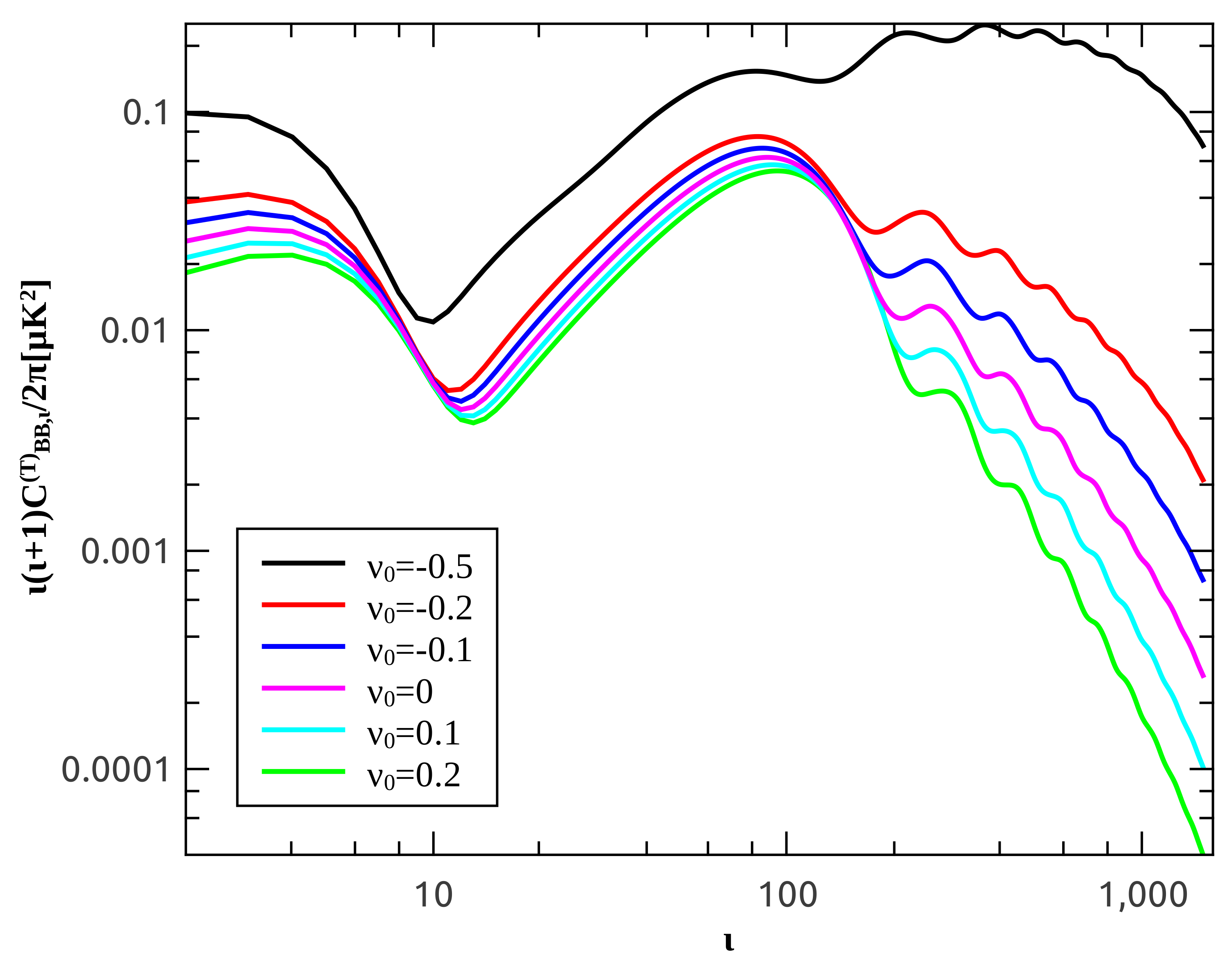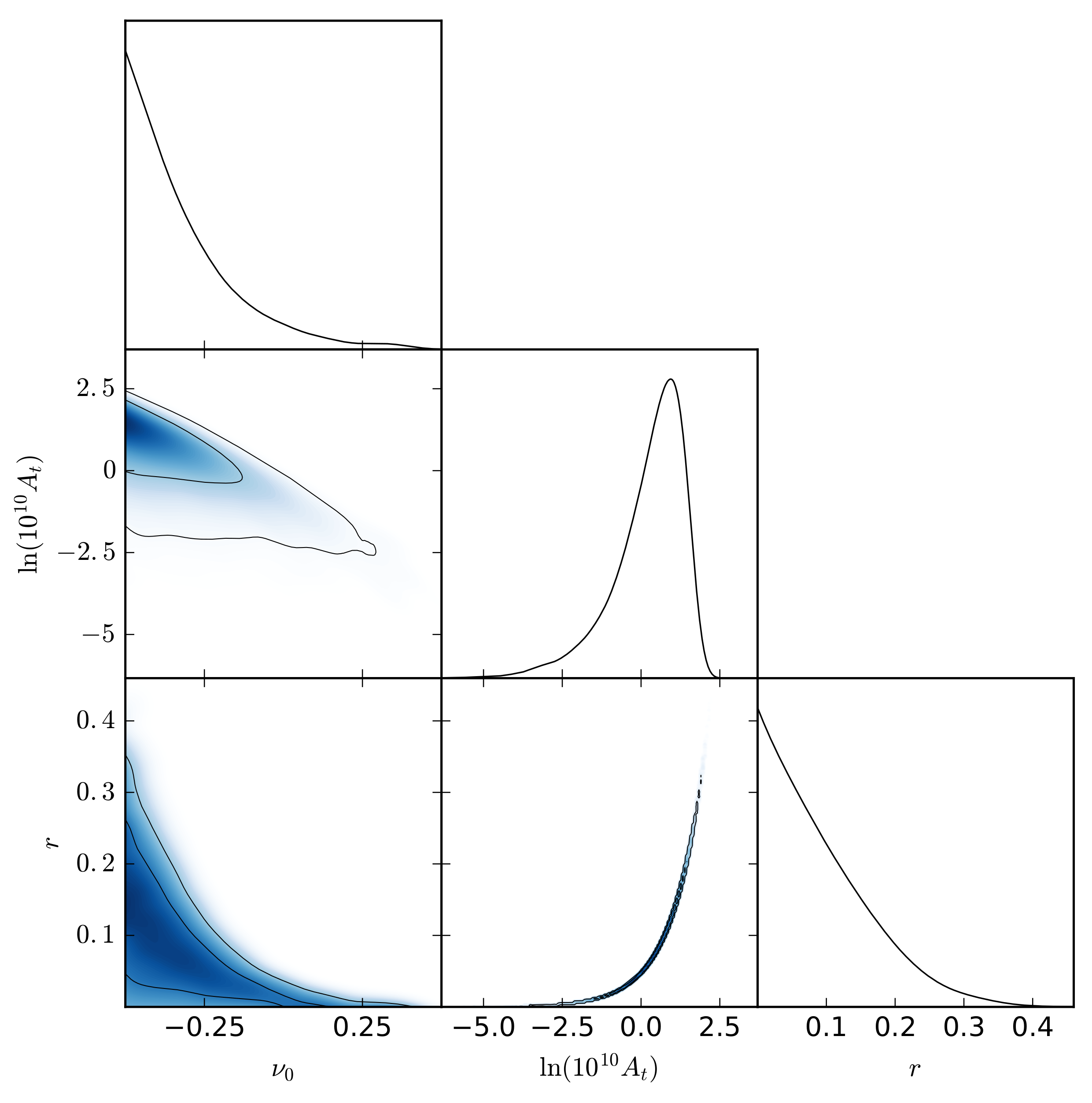Measuring the Modified Gravitational Wave Propagation beyond General Relativity from CMB Observations
Abstract
:1. Introduction
2. The Modified Gravitational Waves Propagation
3. The Constraints on Friction Term from Planck+BK18 Datasets
4. Summary
Funding
Conflicts of Interest
References
- Amendola, L.; Ballesteros, G.; Pettorino, V. Effects of modified gravity on B-mode polarization. Phys. Rev. D 2014, 90, 043009. [Google Scholar] [CrossRef] [Green Version]
- Xu, L. Gravitational Waves: A Test for Modified Gravity. Phys. Rev. D 2015, 91, 103520. [Google Scholar] [CrossRef] [Green Version]
- Lin, W.; Ishak, M. Testing gravity theories using tensor perturbations. Phys. Rev. D 2016, 94, 123011. [Google Scholar] [CrossRef] [Green Version]
- Pettorino, V.; Amendola, L. Friction in Gravitational Waves: A test for early-time modified gravity. Phys. Lett. B 2015, 742, 353–357. [Google Scholar] [CrossRef] [Green Version]
- Ezquiaga, J.M.; Hu, W.; Lagos, M.; Lin, M.X. Gravitational wave propagation beyond general relativity: Waveform distortions and echoes. arXiv 2021, arXiv:2108.10872. [Google Scholar] [CrossRef]
- Belgacem, E.; Foffa, S.; Maggiore, M.; Yang, T. Gaussian processes reconstruction of modified gravitational wave propagation. Phys. Rev. D 2020, 101, 063505. [Google Scholar] [CrossRef] [Green Version]
- Boubekeur, L.; Giusarma, E.; Mena, O.; Ramírez, H. Current status of modified gravity. Phys. Rev. D 2014, 90, 103512. [Google Scholar] [CrossRef] [Green Version]
- Bian, L.; Cai, R.G.; Cao, S.; Cao, Z.; Gao, H.; Guo, Z.K.; Lee, K.; Li, D.; Liu, J.; Lu, Y.; et al. The Gravitational-Wave Physics II: Progress. arXiv 2021, arXiv:2106.10235. [Google Scholar] [CrossRef]
- Brax, P.; Cespedes, S.; Davis, A.C. Signatures of graviton masses on the CMB. JCAP 2018, 3, 008. [Google Scholar] [CrossRef] [Green Version]
- Raveri, M.; Baccigalupi, C.; Silvestri, A.; Zhou, S.Y. Measuring the speed of cosmological gravitational waves. Phys. Rev. D 2015, 91, 061501. [Google Scholar] [CrossRef] [Green Version]
- Cai, Y.F.; Lin, C.; Wang, B.; Yan, S.F. Sound speed resonance of the stochastic gravitational wave background. Phys. Rev. Lett. 2021, 126, 071303. [Google Scholar] [CrossRef]
- Dubovsky, S.; Flauger, R.; Starobinsky, A.; Tkachev, I. Signatures of a Graviton Mass in the Cosmic Microwave Background. Phys. Rev. D 2010, 81, 023523. [Google Scholar] [CrossRef] [Green Version]
- Li, J.; Huang, Q.G. Signatures of Modified Dispersion Relation of Graviton in the Cosmic Microwave Background. JCAP 2018, 2, 020. [Google Scholar] [CrossRef] [Green Version]
- Kobayashi, T. Horndeski theory and beyond: A review. Rept. Prog. Phys. 2019, 82, 086901. [Google Scholar] [CrossRef] [PubMed] [Green Version]
- Felice, A.D.; Tsujikawa, S. Conditions for the cosmological viability of the most general scalar-tensor theories and their applications to extended Galileon dark energy models. JCAP 2012, 2, 007. [Google Scholar] [CrossRef]
- Saltas, I.D.; Sawicki, I.; Amendola, L.; Kunz, M. Anisotropic Stress as a Signature of Nonstandard Propagation of Gravitational Waves. Phys. Rev. Lett. 2014, 113, 191101. [Google Scholar] [CrossRef] [Green Version]
- Bellini, E.; Sawicki, I. Maximal freedom at minimum cost: Linear large-scale structure in general modifications of gravity. JCAP 2014, 7, 050. [Google Scholar] [CrossRef]
- Belgacem, E.; Dirian, Y.; Foffa, S.; Maggiore, M. Modified gravitational-wave propagation and standard sirens. Phys. Rev. D 2018, 98, 023510. [Google Scholar] [CrossRef] [Green Version]
- Belgacem, E.; Dirian, Y.; Foffa, S.; Maggiore, M. Gravitational-wave luminosity distance in modified gravity theories. Phys. Rev. D 2018, 97, 104066. [Google Scholar] [CrossRef] [Green Version]
- Byrnes, C.T.; Hindmarsh, M.; Young, S.; Hawkins, M.R.S. Primordial black holes with an accurate QCD equation of state. JCAP 2018, 8, 041. [Google Scholar] [CrossRef] [Green Version]
- Hajkarim, F.; Schaffner-Bielich, J. Thermal History of the Early Universe and Primordial Gravitational Waves from Induced Scalar Perturbations. Phys. Rev. D 2020, 101, 043522. [Google Scholar] [CrossRef] [Green Version]
- Zhao, W.; Zhu, T.; Qiao, J.; Wang, A. Waveform of gravitational waves in the general parity-violating gravities. Phys. Rev. D 2020, 101, 024002. [Google Scholar] [CrossRef] [Green Version]
- Mancarella, M.; Genoud-Prachex, E.; Maggiore, M. Cosmology and modified gravitational wave propagation from binary black hole population models. Phys. Rev. D 2022, 105, 064030. [Google Scholar] [CrossRef]
- Aghanim, N.; Akrami, Y.; Ashdown, M.; Aumont, J.; Baccigalupi, C.; Ballardini, M.; Banday, A.J.; Barreiro, R.B.; Bartolo, N.; Basak, S.; et al. Planck 2018 results. VI. Cosmological parameters. Astron. Astrophys. 2020, 641, A6. [Google Scholar]
- Ade, P.A.R.; Ahmed, Z.; Amiri, M.; Barkats, D.; Thakur, R.B.; Beck, D.; Bischoff, C.; Bock, J.J.; Boenish, H.; Bullock, E.; et al. Improved Constraints on Primordial Gravitational Waves using Planck, WMAP, and BICEP/Keck Observations through the 2018 Observing Season. Phys. Rev. Lett. 2021, 127, 151301. [Google Scholar] [CrossRef] [PubMed]
- Zaldarriaga, M.; Seljak, U. An all sky analysis of polarization in the microwave background. Phys. Rev. D 1997, 55, 1830–1840. [Google Scholar] [CrossRef] [Green Version]
- Liddle, A.R.; Lyth, D.H. COBE, gravitational waves, inflation and extended inflation. Phys. Lett. B 1992, 291, 391–398. [Google Scholar] [CrossRef]
- Copeland, E.J.; Kolb, E.W.; Liddle, A.R.; Lidsey, J.E. Observing the inflaton potential. Phys. Rev. Lett. 1993, 71, 219–222. [Google Scholar] [CrossRef] [Green Version]
- Riotto, A. Inflation and the theory of cosmological perturbations. ICTP Lect. Notes Ser. 2003, 14, 317–413. [Google Scholar]
- Hojjati, A.; Pogosian, L.; Zhao, G.B. Testing gravity with CAMB and CosmoMC. JCAP 2011, 08, 005. [Google Scholar] [CrossRef] [Green Version]
- Lewis, A.; Bridle, S. Cosmological parameters from CMB and other data: A Monte Carlo approach. Phys. Rev. D 2002, 66, 103511. [Google Scholar] [CrossRef] [Green Version]



Publisher’s Note: MDPI stays neutral with regard to jurisdictional claims in published maps and institutional affiliations. |
© 2022 by the author. Licensee MDPI, Basel, Switzerland. This article is an open access article distributed under the terms and conditions of the Creative Commons Attribution (CC BY) license (https://creativecommons.org/licenses/by/4.0/).
Share and Cite
Li, J. Measuring the Modified Gravitational Wave Propagation beyond General Relativity from CMB Observations. Universe 2022, 8, 367. https://doi.org/10.3390/universe8070367
Li J. Measuring the Modified Gravitational Wave Propagation beyond General Relativity from CMB Observations. Universe. 2022; 8(7):367. https://doi.org/10.3390/universe8070367
Chicago/Turabian StyleLi, Jun. 2022. "Measuring the Modified Gravitational Wave Propagation beyond General Relativity from CMB Observations" Universe 8, no. 7: 367. https://doi.org/10.3390/universe8070367
APA StyleLi, J. (2022). Measuring the Modified Gravitational Wave Propagation beyond General Relativity from CMB Observations. Universe, 8(7), 367. https://doi.org/10.3390/universe8070367




